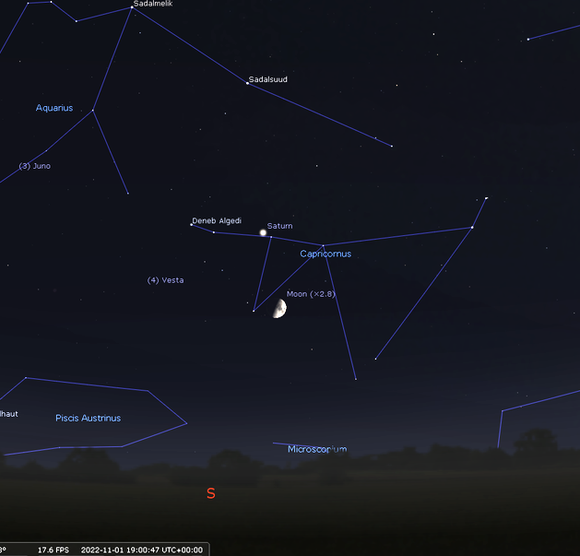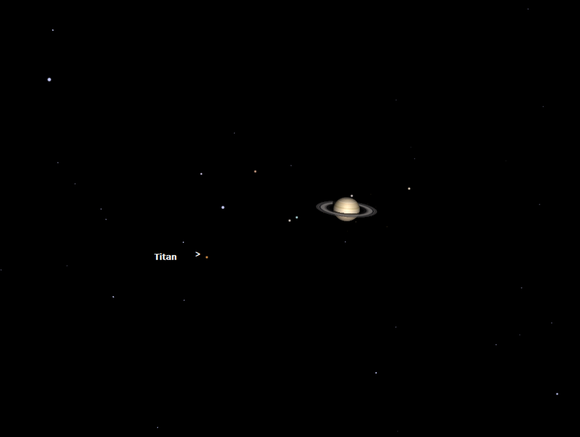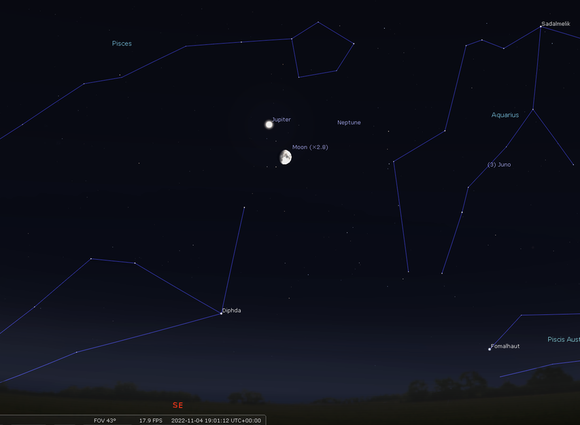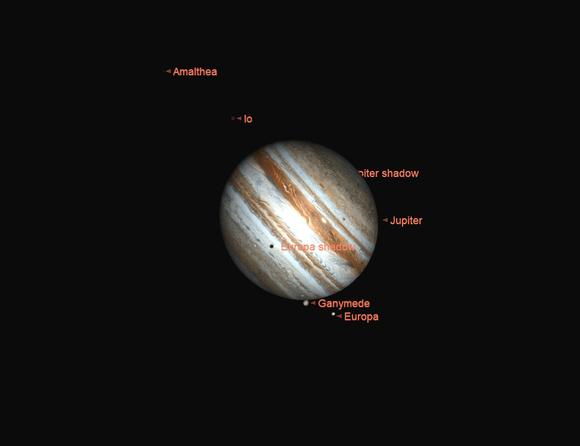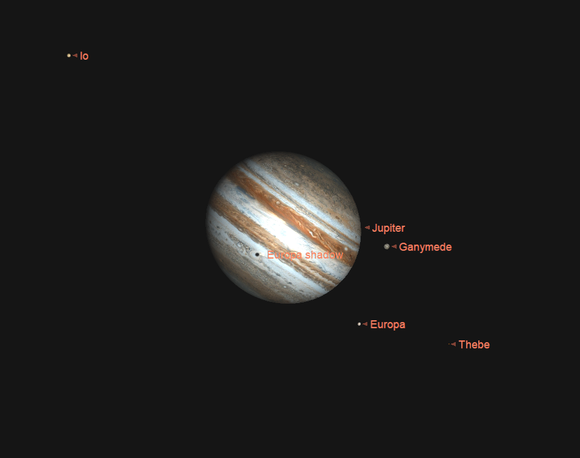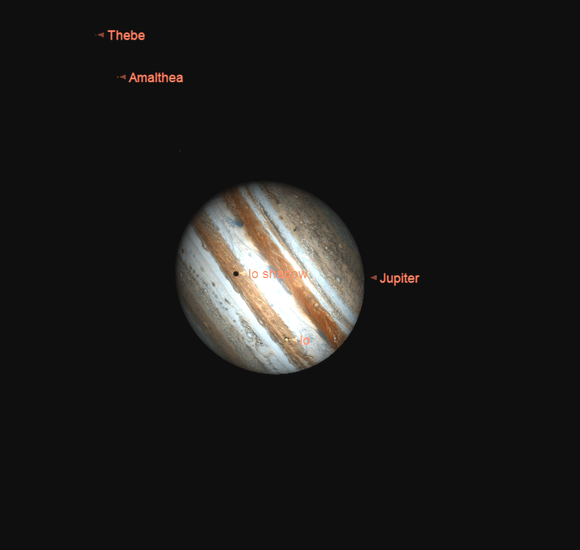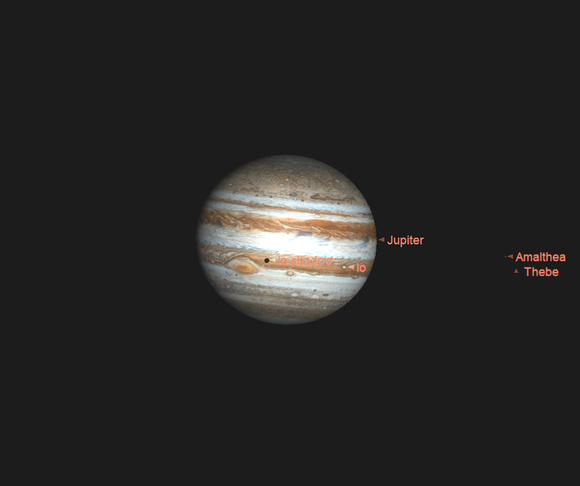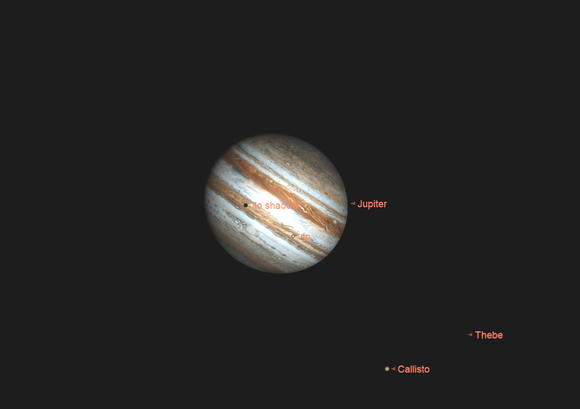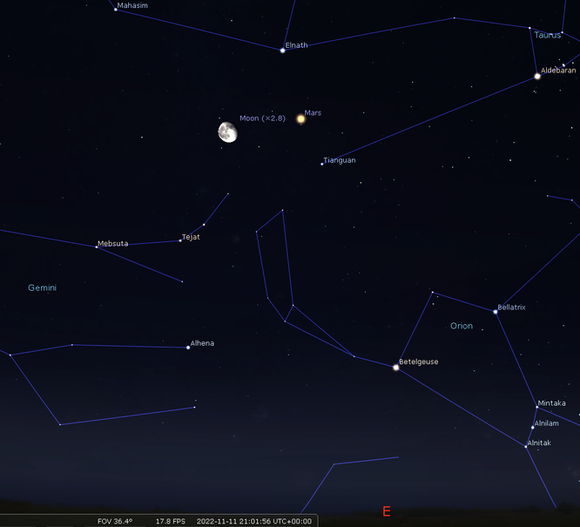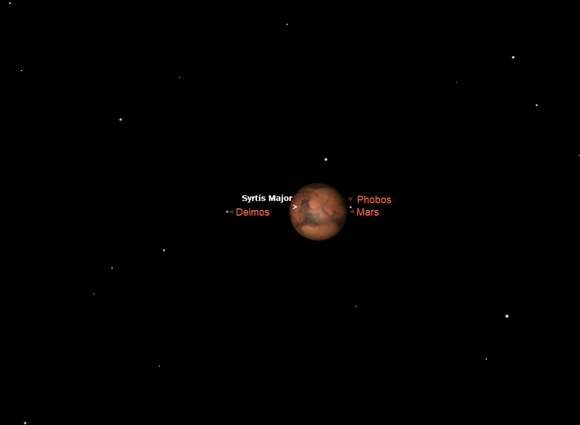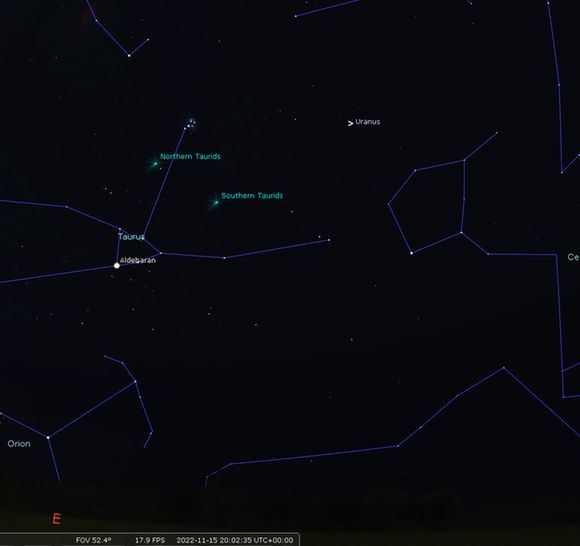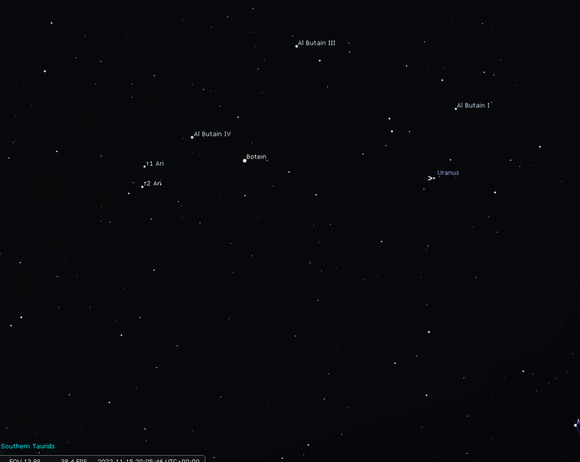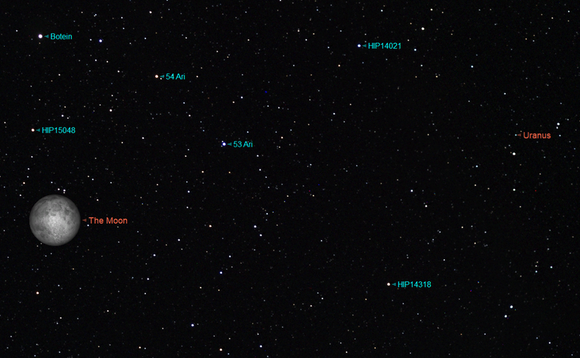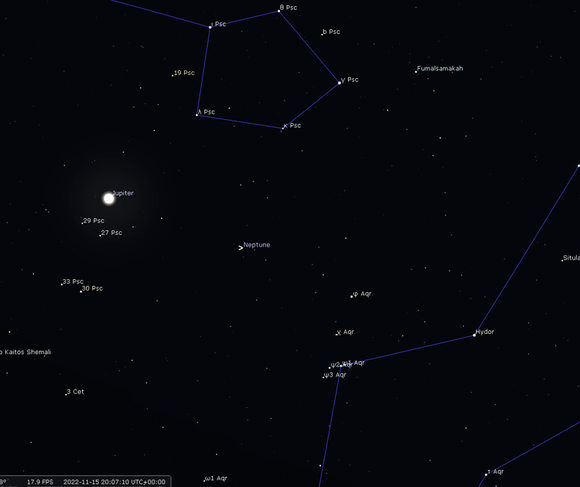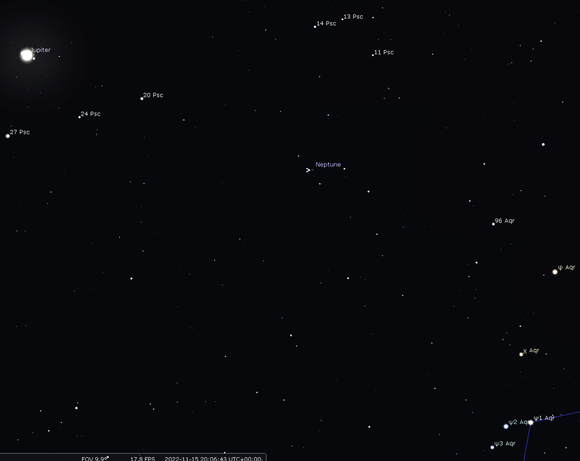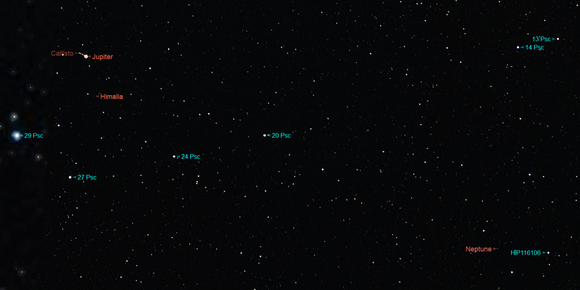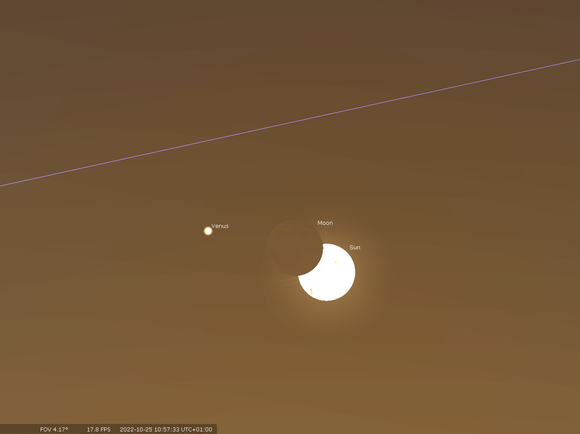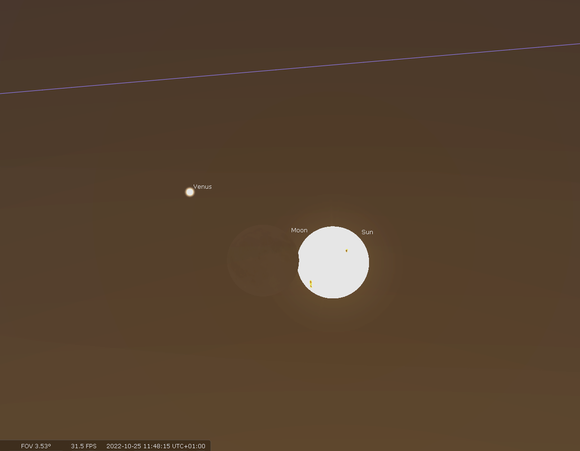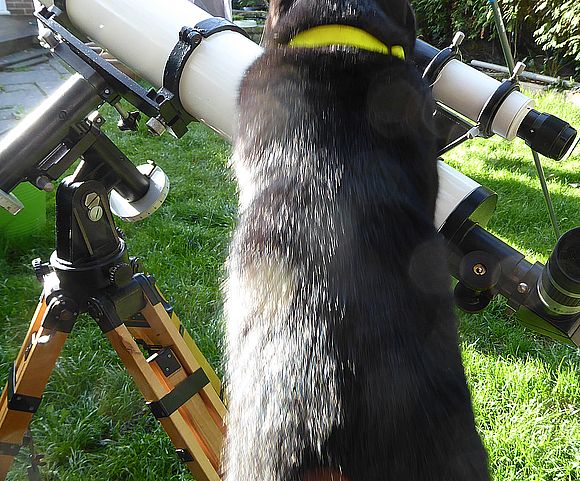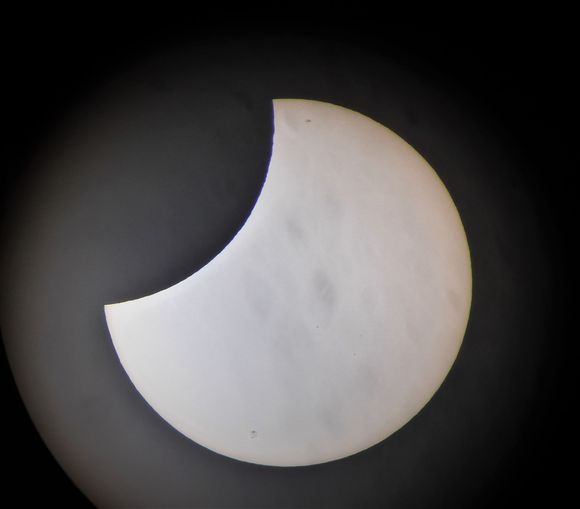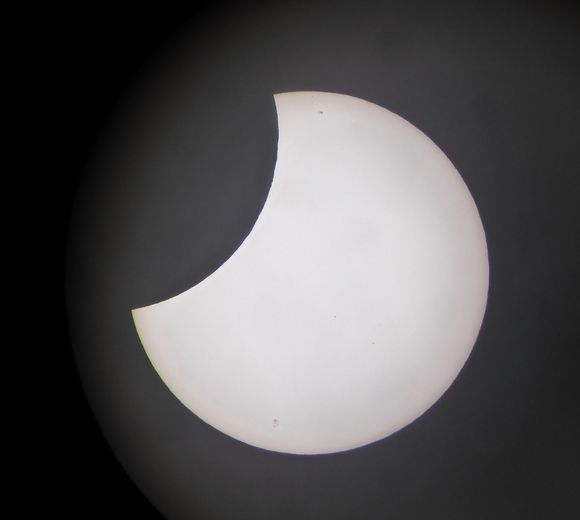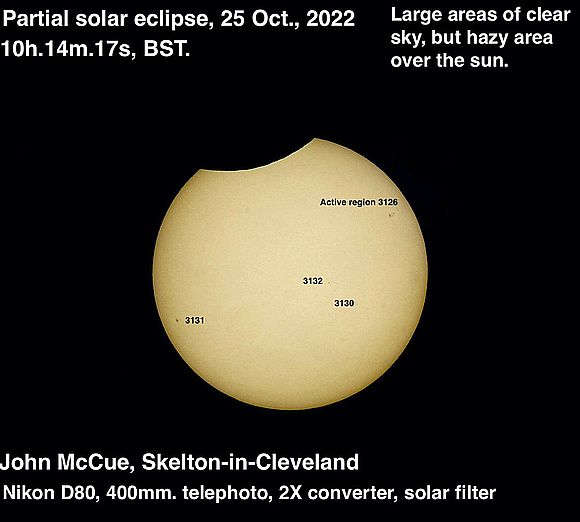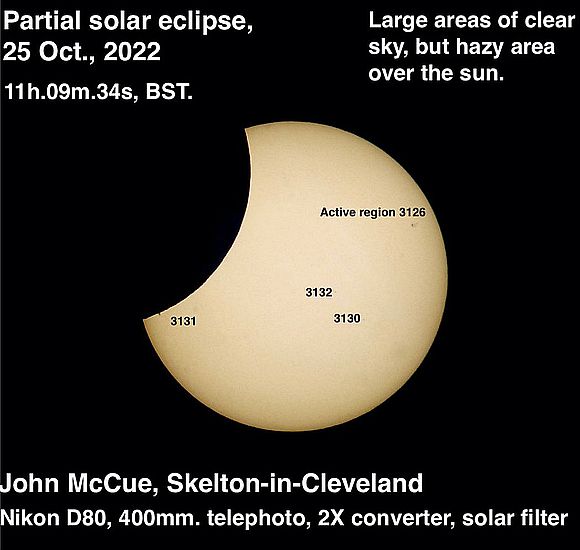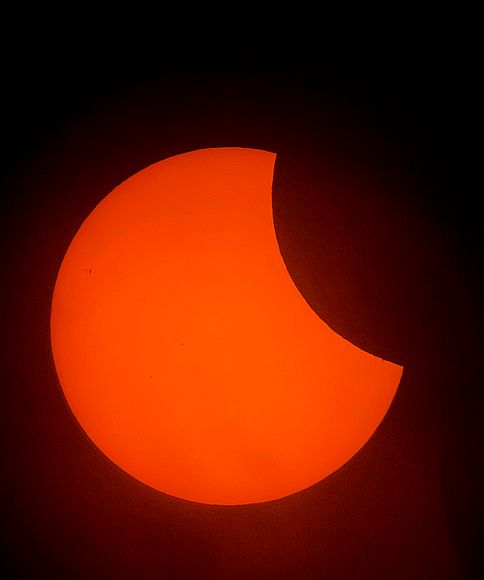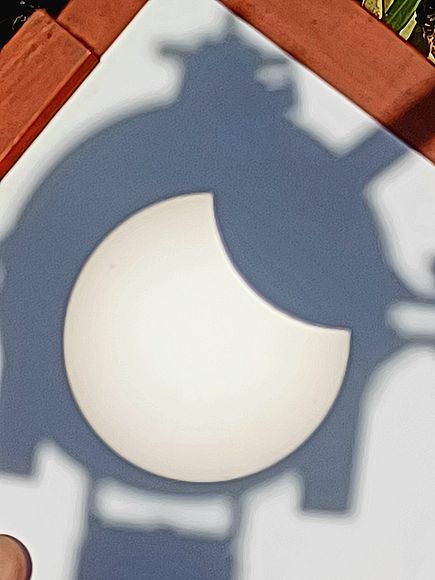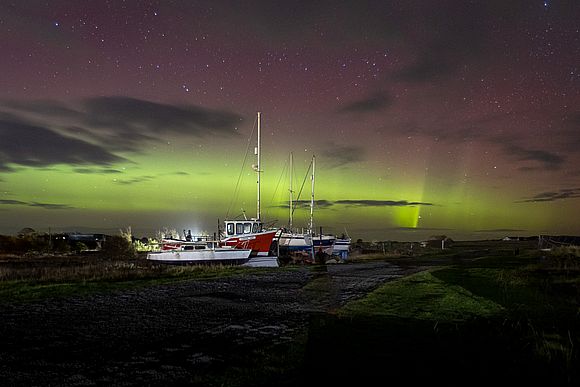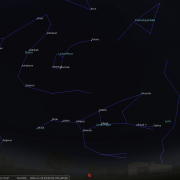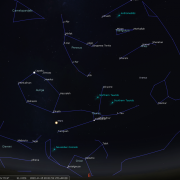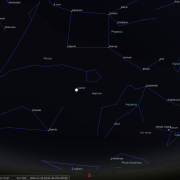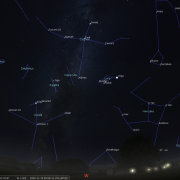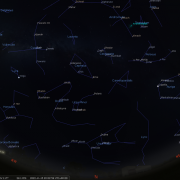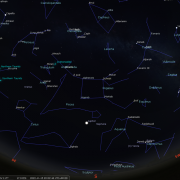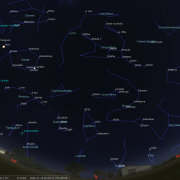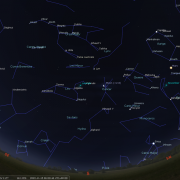In this month's Sky Notes:
- Planetary Skylights.
- Partial Solar Eclipse Report.
- November Meteors.
- November Night Sky.
- November 2022 Sky Charts.
Planetary Skylights - Brief
Jupiter and Saturn are now ideally placed for early evening observations from the UK. Mars grows evermore conspicuous.
 Residing over a hands span ahead of Jupiter amongst the stars of west Capricornus, Saturn remains well placed for early evening observations this month, although it is setting by 22:45 at the start of November and by 21:15hrs at the end of the month. Mid-month it lies due south around 18:00hrs, approximately 20 degrees above the horizon. With an apparent magnitude of +0.7 Saturn is reasonably conspicuous to the naked eye.
Residing over a hands span ahead of Jupiter amongst the stars of west Capricornus, Saturn remains well placed for early evening observations this month, although it is setting by 22:45 at the start of November and by 21:15hrs at the end of the month. Mid-month it lies due south around 18:00hrs, approximately 20 degrees above the horizon. With an apparent magnitude of +0.7 Saturn is reasonably conspicuous to the naked eye.
Through the eyepiece Saturn appears almost 19 arc seconds in diameter with the rings spanning 42 arc seconds. The rings are a magical sight and remain favourably orientated with respect to Earth; the North Pole tilted over 12 degrees toward us, taking another 4 years before we arrive at the next ring plane crossing event.
Telescopes of apertures 80-100mm (3.5 - 4") will reveal the brightest rings (A & B) separated by the Cassini Division. Ring C, which lies closest to Saturn is more difficult to discern. Saturn's largest moon, Titan, is noticeable as a speck of light nearby and at mag +8.4 may be spied in small scopes. Titan takes just under 16 days to orbit around Saturn. Instruments of 200mm + (8") may also reveal Rhea, Tethys and Dione. A waxing Qtr phase Moon lies directly below Saturn overnight of November 1st/2nd. By December Saturn will increasingly become a very early evening object - so the observing clock is ticking with regard to satisfactory views of the ringed wonder.
 At magnitude -2.6 Jupiter remains the most dominant planetary object in the night sky, and will be at its prime for UK observers, located due south mid-month around 20:30hrs. Residing below the faint ‘loop’ stars of Pisces, and culminating a respectable 35 degrees above the horizon, planetary observers still have plenty of opportunity to scrutinise Jupiter over the course of November, not setting until well after midnight, even by the end of November.
At magnitude -2.6 Jupiter remains the most dominant planetary object in the night sky, and will be at its prime for UK observers, located due south mid-month around 20:30hrs. Residing below the faint ‘loop’ stars of Pisces, and culminating a respectable 35 degrees above the horizon, planetary observers still have plenty of opportunity to scrutinise Jupiter over the course of November, not setting until well after midnight, even by the end of November.
Through the eyepiece Jupiter is a magnificent sight, the oblate disk appearing an impressive 47 arc seconds in diameter in the eyepiece, with plenty to interest all levels of observing experience. It is fascinating to study through a telescope, noting any changes to disk features, including the banding and GRS (Great Red Spot). The Great Red Spot (GRS) is a colossal storm system, which over the last few decades appears to have diminished in size and hue intensity and is now carefully monitored by astronomers. It is visible in apertures of 100mm (4") and above.
Jupiter is flanked by the Galilean moons' seen as specks of light close by, but planetary sized worlds in their own right. Regular observers of the Jovian system will note the 'dance' of Io, Europa, Ganymede and Callisto around Jupiter, throwing up a different configuration each night, with shadow transits particularly facsinating to follow. If you have a 4" (100mm) aperture scope' and above, shadow transits of moons passing on the near side of Jupiter will be visible, jet black dots of varying size dependant on which moon is involved. The actual moons themselves are more difficult to spot as they pass in front of Jupiter, requiring much larger apertures. The most favourable evening shadow transits this month are Europa; Nov 2nd @ 23:30hrs and Nov 27th @ 18:30hrs. Io Nov 10th @ 21:40hrs; Nov 17th @ 23:30hrs and Nov 19th @ 18:00hrs. A waxing gibbous Moon lies directly below Jupiter overnight of Nov 4th/5th.
 Mars will take a leap forward in terms of being conspicuous to the eye and in the eyepiece this month, growing in brightness from magnitude - 1.27 at the start of November and reaching - 1.9 by the end of the month when just a week away from opposition in December. Residing between the 'horn stars' in Taurus, Mars will be visible above the NE horizon by 19:00hrs at the start of the month and will be already apparent as dusk gathers at the end of November. The 'red planet' become a viable observing target in the evenings after midmonth as it climbs ever higher, culminating in the early morning hours around 60 degrees above the S horizon. At that altitude and brightness, the image through the eyepiece for UK observers should be superior to anytime over the last few decades with a disk size of almost 19 arc seconds to scrutinise, and it’s the surface we are gazing at!
Mars will take a leap forward in terms of being conspicuous to the eye and in the eyepiece this month, growing in brightness from magnitude - 1.27 at the start of November and reaching - 1.9 by the end of the month when just a week away from opposition in December. Residing between the 'horn stars' in Taurus, Mars will be visible above the NE horizon by 19:00hrs at the start of the month and will be already apparent as dusk gathers at the end of November. The 'red planet' become a viable observing target in the evenings after midmonth as it climbs ever higher, culminating in the early morning hours around 60 degrees above the S horizon. At that altitude and brightness, the image through the eyepiece for UK observers should be superior to anytime over the last few decades with a disk size of almost 19 arc seconds to scrutinise, and it’s the surface we are gazing at!
Compare the lustre of Mars to the nearby chief star in Taurus; Aldeberan, both of orange hue. Mars is in retrograde motion (east to west), gathering momentum as the month wears on and drifting toward and above Aldebaran. This direction of travel will come to a halt by mid January, resuming a prograde motion back toward the horn stars thereafter. For all those with modest backyard scopes, start to look for surface details and features later in the month, in particular the distinctive 'fin' shape feature of Syrtis Major from Nov 22nd to the 30th at 23:00hrs. The Moon lies nearest to Mars on Nov 10th/11th.
Mars through the eyepiece - med/high magnification - November 25th - 22:00hrs
(click for larger image)
 Uranus arrives at a distant 2.8 billion Km opposition point on November 8th, over 18 times the Earth-Sun distance. Located in the lower reaches of Aries, Uranus is well clear of horizon murk culminating around 50 degrees above the south horizon by midnight. At magnitude +5.7, Uranus is just about visible to the naked eye, but dark, transparent, skies are required to achieve this, something that won't be present on the 8th when the Moon is full! You would have to attempt this later on in November. Uranus can be spotted as a star-like object through binoculars, but the miniscule disk; ghoulish grey/green in hue and just 4 arc seconds in diameter, is revealed only with telescopes of apertures 75mm (3") and greater at medium magnification.
Uranus arrives at a distant 2.8 billion Km opposition point on November 8th, over 18 times the Earth-Sun distance. Located in the lower reaches of Aries, Uranus is well clear of horizon murk culminating around 50 degrees above the south horizon by midnight. At magnitude +5.7, Uranus is just about visible to the naked eye, but dark, transparent, skies are required to achieve this, something that won't be present on the 8th when the Moon is full! You would have to attempt this later on in November. Uranus can be spotted as a star-like object through binoculars, but the miniscule disk; ghoulish grey/green in hue and just 4 arc seconds in diameter, is revealed only with telescopes of apertures 75mm (3") and greater at medium magnification.
Perhaps the most difficult aspect of locating Uranus is indentifying the general area of sky it currently resides, a 'no man's land' devoid of apparent naked eye stars below Aries, west of Taurus and to the east of Cetus and Pisces. The nearest 'bright' apparent naked eye star is sigma Ari at magnitude +4.35, which sits 1.5 degrees upper left of Uranus. Over the course of a month you will notice the movement of Uranus in comparison to background stars. On Nov 8th Uranus sits a little over 4 degrees east of the Full Moon.
 Remote Neptune is well placed for observation in the evening sky residing amongst the stars of northern Aquarius, some 6 degrees to the right of Jupiter. At a distance of 4.32 billion Km, Neptune appears a feeble magnitude +7.8 object, visible in binoculars as a speck only, a telescope with an aperture of at least 100mm (4") + is required to reveal its tiny blue/grey disk barely 2.5 arc seconds in diameter. Although Neptune resides just within the borders of Aquarius, the closest visible star is the mag +5.5 star 20 Piscium (HIP 117375), with 96 Aqr almost the same distance to the SW of Neptune.
Remote Neptune is well placed for observation in the evening sky residing amongst the stars of northern Aquarius, some 6 degrees to the right of Jupiter. At a distance of 4.32 billion Km, Neptune appears a feeble magnitude +7.8 object, visible in binoculars as a speck only, a telescope with an aperture of at least 100mm (4") + is required to reveal its tiny blue/grey disk barely 2.5 arc seconds in diameter. Although Neptune resides just within the borders of Aquarius, the closest visible star is the mag +5.5 star 20 Piscium (HIP 117375), with 96 Aqr almost the same distance to the SW of Neptune.
Annually, Neptune is gradually gaining in altitude and not since the late 1940s has it been this far north in the sky for UK observers (34 degrees), a trend which is going to continue for several more decades, in fact it won't be until the late 2060s before Neptune attains its greatest altitude above the S horizon - almost 60 degrees in Gemini! The Moon lies approximately 4 degrees below Neptune on Nov 4th.
Partial Solar Eclipse
There was a partial solar eclipse visible from the UK on the morning of October 25th. From the Whitby area coverage was around 27% at maximum, a 'small bite' out of it, but wherever you were, hopefully you managed to view safely and successfully, even taking the opportunity to capture a few images of the event. Below is what it should have looked like from Whitby according to the Stellarium program, and lo and behold, it pretty much did look like this. Skies were clear for the most part (some hazy high cloud was present), but society members did take advantage, viewing the eclipse and taking images from various locations.
Utilizing a pair of eclipse glasses to view the start of the eclipse shortly after 10:00hrs, Mark D was able to gauge when to rush back home from work and capture a few images near maximum coverage. This occurred shortly before 11:00hrs. Utilising a TAL refractor, neutral density filter and hand held Lumix TZ70 camera to the eyepiece and with assistance from Kenny the cat, who was 100% adamant he wanted to be in charge of the telescope, Mark captured a few images. Absconding for just 20 minutes (10 minutes either side of maximum) Mark was unable to follow the rest of the eclipse, dashing back to work leaving Kenny in charge. Clearly visible though are several sunspot groups, the one toward the bottom (3131) being covered by the Moon later in the eclipse. Mark missed this .... However
... John McCue managed to follow most of the eclipse from near Skelton, taking images documenting its progress, including several where sunspot group 3131 is hidden by the lunar limb. Note that the lunar limb is noticeably more rugged on all the images near the top of the 'bite'.
Other society members also managed to capture the eclipse. Paul Woods used an iPhone SE and 3.5in Questar with full aperture solar filter and a 32mm Brandon eyepiece to capture the image below.
Phil and Elaine managed to capture the partial from their back garden in Ruswarp, and used the projection method to do so.
And, although not of the eclipse, but certainly related to the Sun in the guise of solar activity and its influence on Earth, society member Richard Randle whilst on holiday captured this beautiful aurora scene from Holy Island on October 22nd. The image was made stitching 5 portrait shots together and then cropping.
A stunning scene of the aurora borealis over Holy Island.
Image taken by society member Richard Randle (click for larger)
Meteor Activity - November
The Leonids are active from Nov 15-20th, peaking over the night of the 17/18th in 2022. The actual peak activity time for the shower is predicted to be around 23:00hrs UT on Nov 17th, however from the UK, Leo, in which the radiant of the shower resides, is only just rising at that time. The early morning to pre-dawn hours should therefore yield the higher rates when Leo culminates in the south of the sky as dawn breaks. There is a catch though (as seems to be the case this year with all meteor showers), with a waning crescent Moon present in Leo 25 degrees away from the radiant. Normally spotting meteors occurs well away from the location of the radiant itself, so it may not interfere to the complete detriment of the shower, we shall see, clouds permitting.
Famously associated with comet 55/P Temple-Tuttle, which returns to the inner solar system every 33 years, leading to 'storm rates' of 100s, 1000s and even 100,000s meteors per hour, over the last decade or so Leonid rates have been very modest; 10-15 per hour the norm. There is a suggestion that rates may be higher this year, with an increased number of fireballs as a result of Earth passing through a denser strand of cometary debris left behind at its 1733 return. Leonids are some of the swiftest meteors, penetrating the upper atmosphere at speeds of 45mps or 72 km/second, often leaving bright and persistent trains in the sky. If the night of 17/18th is clear, keep one watchful eye open at least!
Also in November keep the other eye open for a few meteors on the night of Nov 4/5th when the South Taurid meteor shower reaches a peak. A second peak on the night of Nov 11/12 for the North Taurid meteor shower will be severely impacted by a gibbous Moon. The hourly rate is low for both showers; only around 5 meteors, but these can be bright with occasional fireballs! The Taurids are an old shower, associated with the periodic Comet Enke. Over time dust from this comet has been depleted and spread out over a broad swath of the inner solar system, giving rise to Taurid meteor showers not only on Earth, but also on Mars and Venus too!
November Night Sky
November can feel like a transitional month, trees shed their colourful leafy autumn coats, a definite chill accompanies the arrival of dawn, even the air smells autumnal in the UK (smoke and gunpowder). Skies are dark by 18:00hrs, filled with sparkly stars, frost bitten only occasionally these days as the impact of climate change seems to insulate us from any sign of early wintery conditions. The celestial tapestry slowly evolves, the stellar canopy of winter clambers over the east horizon, yet even now in one aspect of the sky; the west, summer still lingers. Here the stars of the summer triangle; Vega, Deneb, Altair and associated constellations, remain conspicuous as darkness falls, well suited for observations in the early evening. Deneb shines atop the Northern Cross (Cygnus), which now really does resemble the outline of a crucifix as it descends towards the WNW horizon. High in the NW, brilliant steely-blue Vega illuminates the lozenge outlne of Lyra, both it and Deneb circumpolar from our latitude and remain visible throughout winter, dipping close to the north horizon. Altair in Aquila the Eagle will depart our skies mid-month shortly after 22:00hrs.
Facing north the familiar ‘saucepan’ outline of the Plough has now reached its lowest station on its endless journey about the celestial pole conveniently marked (almost) by Polaris - the Pole star, situated a couple of hand-spans above the Plough’s bowl stars. Utilise the pointer stars; Dubhe and Merak for this purpose. Polaris sits at the tip of Ursa Minor’s tail. Between these two celestial bears wind the faint stars of Draco, the head of which, marked by an irregular quadrilateral, resides to the right of Vega in the WNW. Use the 'arc' of the Plough's handle to locate the brilliant star Arcturus setting in the NW, although the very top of its parent constellation, Bootes, will remain above the north horizon from this UK latitude. Also departing with Bootes, Corona Borealis and the upper body of Hercules (technically lower body as Hercules is depicted as being upside down in the heavans on charts). Their absence is but temporary, visible again in the NE well before dawn.
Due South, arranged below the great square of Pegasus reside the constellations of Pisces and Aquarius, neither group blessed with conspicuous stars, Jupiter currently resides below Pisces, as too does Cetus the whale, use the front two stars in the square to locate the 'Krakens' brightest star Diphda. The most famed object in Cetus is the variable star omicron ceti - otherwise known as Mira the wonderful, an extraordinary pulsating red super giant up to 300 million miles in diameter. When at maximum, a period lasting some 10 days, Mira is easily visible to the naked eye and can rival Menkar. Mira’s slow decline to minimum takes seven months by which time binoculars struggle to pick out the +10.2 star! The whole period takes 332 days, with the next maximum not expected until June 2023. Mira lies roughly midway between Menkar and Diphda. Capricornus occupies the SSW horizon, departing mid-evening skies by the month's end. Do try to spot conspicuous Fomalhaut in Pisces Austrinus, visible just above the SW horizon during early/mid evening until around 20:00hrs. It is the most southerly of first magnitude stars to rise over UK mainland shores. Scheat and Markab in the square point down to it.
High to the South, stretching eastwards away from Pegasus, the stars of Andromeda sweep up toward the heroic figure of Perseus climbing high into the ENE. The constellation of Perseus itself lies partly within the rich Milky Way and is well worth exploring with augmented eyes, whether binoculars or a telescope. Alpha Persei or Mirphak (sometimes written Mirfak) is the brightest star in the constellation, however, Beta Persei, or Algol is of far more interest. The name Algol (Demon's head) is derived from an Arabic name, Ras al Ghul, a 'Ghul' being a nightmare which haunted and ultimately destroyed men. Star maps in antiquity depict Perseus holding the severed head of Medusa, which is marked by Algol, but it is doubtful if the Arabs knew of the Perseus–Medusa legend. In early antiquity it was noted with much consternation that this star appeared to ‘wink’ every third night, fading in brightness before returning to its former glory. The Greeks probably noted the mysterious phenomena first, but many ancient and medieval astrologers considered Algol the most dangerous and unfortunate of stars. Science has long since uncovered the truth, we now know it to be a eclipsing binary star - two stars in orbit about one another, one bright and the other fainter. Every 2 days and 21 hours the fainter star passes in front of its more luminous companion, and the overall light output from Algol drops. It remains thus for almost 10 hours before the eclipse ends, thereafter the ‘demon star’ returns to normal.
Also in this part of the sky, seek out the superb 'Double Cluster', an exquisite duo of galactic star clusters that lie midway between Perseus and Cassiopeia and mark the sword hand of Perseus. Visible as misty knots in binoculars, at low magnification through a small/medium scope H and Chi Persei is one of the loveliest sights in the heavens. Perseus is of course the hero in one of the best known mythologies, saving the sacrificial Princess Andromeda from the Cracken sea monster sent to devour her and ravage the coastal towns and cities of ancient Etheopia, the Kingdom of boastful Queen Cassiopeia and her husband King Cepheus. The winged horse of Pegasus, being a more modern insertion into this ancient legend.
All of these constellations are arranged across the autumn sky to the South and East, Pegasus and Perseus we have already visited. The faint pattern of Cepheus is located overhead during November evenings and resembles the outline of a crooked house. (see October night sky feature) Cassiopeia, the 'W', is a most distinctive constellation, for obvious reasons, well worth exploring with a pair of binoculars or telescope, especially as the Milky Way flows through it. Following behind Perseus the imposing pentagonal shape of Auriga- the Charioteer illuminated by brilliant Capella, is climbing away from the NE horizon and will by mid-December shine down from the zenith position overhead.
Later in the evening seasonal winter constellations become ever more prominent as they emerge over the eastern horizon. Leading the way is Taurus, which adjoins below Auriga. Taurus is home to the open star clusters, the Pleiades and the Hyades. Prominent ruddy Aldebaran - “the eye of the bull’ is a conspicuous presence in the Hyades, a ‘V’ or arrowhead arrangement of stars, though it is not a genuine member, lying at half the distance of the true members. Mars is currently residing in Taurus - toward the horn stars and is far more brilliant than Aldebaran but of similar hue. The bull’s tail, which sits upper right of the Hyades is marked by the Pleiades, or ‘Seven Sisters’, regarded as perhaps the loveliest open star cluster in the entire heavens and one of the most youthful by stellar standards. To the casual glance the Pleiades appear as beads of dew on a frosty web. Keen sighted observers can make out more than seven stars with the naked eye, although most people see five or six. Binoculars, or very low telescopic magnifications reveal dozens of stars and the entire cluster contains over 300 members approximately 400 light years away. The Pleiades are presently placed midway between Perseus and the east horizon.
From Greek mythology the Pleiades were the seven daughters of Atlas and the Oceanid Pleione, after whom they are named. Orion is said to have pursued the sisters for seven years after trying to ravish them and their mother. Zeus immortalized the chase by placing the Pleiades in the heavens. This is of course just a tale, but ancient Aztec and Mayan traditions tell of real and gruesome rituals associated with the Pleiades. Then, the midnight culmination of the star cluster was an event of ominous significance, especially so every 52 years when time lines of separately used calendars converged. Believing the world would end at such times, temple steps would run red with the blood of virgins, sacrificed in order to postpone the approaching apocalypse. Travel to Mexico today and many of the sacred ‘step’ pyramids have their west face orientated to the setting position of the Pleiades.
Climbing over the NE horizon are the stars of Gemini, the Twins, the heads of whom are conveniently marked by the first magnitude stars Castor and Pollux. Finally, perhaps the most majestic of all constellations, Orion, complete with starry belt and bright supergiant stars, clears the SE horizon by 22:00hrs. Over the coming winter months, Orion and his stellar retinue will be the focus of our celestial rambles.
November 2022 Sky Charts
Additional Image Credits:
- Planets and Comets where not otherwise mentioned: NASA
- Sky Charts: Stellarium Software and Starry Night Pro Plus 8
- Log in to post comments

